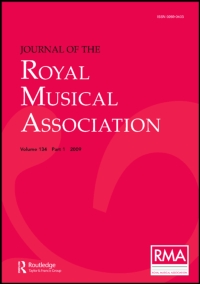No CrossRef data available.
Article contents
On the Principles of Musical Notation
Published online by Cambridge University Press: 01 January 2020
Extract
Some apology seems necessary for reading a Paper on such a well-worn subject as Notation, especially before those who are not only familiar with it themselves, but in many cases occupied daily in teaching or explaining its principles to others. But Music has now become so universally a part of education, that it is of the utmost importance that we should have the best possible system of notation; and I take it, that the remarkable extent to which thoughtful musicians have lately turned their attention to this subject, and the many alterations which have from time to time been suggested by them, prove that some dissatisfaction is felt with existing systems. That there should be some opposition between rival methods is natural enough, but I think much of this opposition would disappear, could we be brought to consider calmly not so much the merits as the demerits of that particular system in which we live and move. For, having mastered its intricacies, we cease to believe in their existence; and having by long usage condoned its faults, we become loth to admit them to be faults at all. Those among you who happen to be special advocates of, and whose names are by common consent associated with, rival systems, will, I hope, understand that none of my remarks are intended to be personal; and that my only desire to-day is to ask you to consider calmly with me what are the true principles of Musical Notation, and how far those systems now in common use are built upon these principles.
- Type
- Research Article
- Information
- Copyright
- Copyright © Royal Musical Association, 1874
References
∗ To this the numerical system should have been added. The use of the numbers 1, 2, 3, 4. 6, 6, 7, instead of the letters A, B, C, &c., or of the words do, re, mi, is common in France; but it docs not differ in principle from an alphabetical system.Google Scholar
∗ The modern use of the G clef, both for the treble and tenor parts, does to a certain extent deprive clefs of their claim to be signs of absolute pitch. The late Mr. Oliphant suggested and used a sort of duplicate sign to distinguish the tenor part from the treble. Some difference of shape seems desirable.Google Scholar
∗ Since writing the above I have found that the proposed system has been used, to a limited extent, both in England and America, and with marked success.Google Scholar
A correction has been issued for this article:
Linked content
Please note a has been issued for this article.


